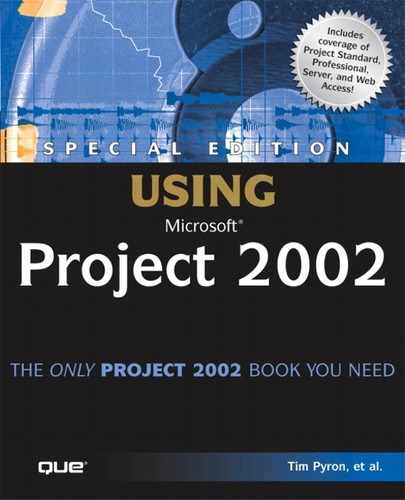Troubleshooting
Locating the GLOBAL.MPT File
How do I copy my GLOBAL.MPT file to a disk so that I can share it with someone else?
GLOBAL.MPT might be located in several locations on your hard drive, depending on which operating system your computer is using. You can easily locate both the original GLOBAL.MPT backup file and the active GLOBAL.MPT file, with any custom objects that have been copied to it, by using the Microsoft Windows Search feature, which you access by selecting Start, Search, For Files or Folders. It is important that you check the date on which each file was last modified to ensure that you copy the correct one (the original, backup copy is the oldest GLOBAL.MPT file).
Specifying Where Project Locates GLOBAL.MPT
In Project 98, there were two places where Project looked for the GLOBAL.MPT file on startup: the current folder and the folder containing the winproj.exe file. So if I customized my GLOBAL.MPT file and designated a specific folder to use on startup, I would be able to use my custom GLOBAL.MPT file instead of the default GLOBAL.MPT file. I understand that this changed in Project 2002. Can you explain how?
When Project 2002 starts, it first looks to see if there are any Registry policy keys. An organization can add one or both of these keys to the Registry to control access to the GLOBAL.MPT file that is used by its users. This prevents users from making modifications to GLOBAL.MPT. The first key, RootKey, establishes the location where Microsoft Project should find GLOBAL.MPT (for example, on a network drive). If this key exists but the file or location named in the key doesn’t exist, Project displays an error message and refuses to start. A second additional permissions key can be set to indicate whether Project users are restricted to using just the GLOBAL.MPT file in the RootKey location, or if they can use a GLOBAL.MPT file from another location—such as their own, customized GLOBAL.MPT file located in the language folder (1033, for example).
Project 2002 uses the following registry keys:
HKEY_CURRENT_USERSoftwarePoliciesMicrosoftOffice9.0MS ProjectGlobalSearch Data: RootKey Value: <Full path to Global.MPT> Type: REG SZ HKEY_CURRENT_USERSoftwarePoliciesMicrosoftOffice9.0MS ProjectGlobalSearch Data: Permission Value: <0 or 1> // 0 = not restricted, 1 = restricted Type: REG DWORD
If these registry keys don’t exist, Project looks for the GLOBAL.MPT file in the following places, in the order listed (depending on the user’s operating system):
In the current folder— If you establish a shortcut to start Project, you can designate a default “start in” folder. If there is a GLOBAL.MPT file in this folder, Project uses that GLOBAL.MPT file. Likewise, if you double-click on a project file in Windows Explorer, if a GLOBAL.MPT file resides in the same folder as the project file, Microsoft Project uses that GLOBAL.MPT file.
In the user’s profile folder— Project looks in the user’s profile folder, which is likely to be C:WindowsProfilesUsername Application DataMicrosoftMS Project, where Username is the user’s name.
In the user’s profile language folder— Project looks in the user’s profile language folder, which is likely to be C:WindowsProfilesUsername Application DataMicrosoftMS ProjectLanguageNumber , where Username is the users name and LanguageNumber is the numeric folder name indicating the language of the version of the project installed (for example, 1033 for English).
In the same folder that contains the Winproj.EXE file— By default this file (which is the main Project program file) is located in C:Program FilesMicrosoft OfficeOffice.
In the Winproj.EXE language folder— The Winproj.EXE language folder is located in C:Program FilesMicrosoft OfficeOfficeLanguageNumber , where LanguageNumber is the numeric folder name indicating the language of the version of project installed (for example, 1033 for English).
If GLOBAL.MPT cannot be located, then the Windows Installer starts and attempts to restore a copy of the GLOBAL.MPT file to the Winproj.EXE language folder. If the Windows Installer is unable to restore a copy of GLOBAL.MPT (such as when the Project installation files are not available), a message appears, indicating that a new GLOBAL.MPT file will be created but that it might be missing some items.
